-
Paper Information
- Previous Paper
- Paper Submission
-
Journal Information
- About This Journal
- Editorial Board
- Current Issue
- Archive
- Author Guidelines
- Contact Us
American Journal of Economics
p-ISSN: 2166-4951 e-ISSN: 2166-496X
2020; 10(1): 21-28
doi:10.5923/j.economics.20201001.04

Optimising the ‘Economics of Curiosity’ for Better Future Foresight
Mohamed Buheji
International Inspiration Economy Project- Bahrain
Correspondence to: Mohamed Buheji, International Inspiration Economy Project- Bahrain.
| Email: buhejim@gmail.com |
Copyright © 2020 The Author(s). Published by Scientific & Academic Publishing.
This work is licensed under the Creative Commons Attribution International License (CC BY).
http://creativecommons.org/licenses/by/4.0/

We are living in a complex world where curiosity is becoming an essential element. This paper explores the economics that are derived by curiosity and how it would help us to bring better future foresight. The methodology tracks how curiosity flows that lead to the creation of the outcome of the model. A framework for optimising the curiosity economy is finally proposed. The paper concludes with recommendations of further studies on how curiosity would help in creating future sustainable outcomes compared to the foresighted socio-economic challenges. The implications of this work would reflect on more understanding of the curiosity influence on the future socio-economic dynamics and the efforts that can be taken by any country or community to avoid the coming challenges.
Keywords: Curiosity, Economics of Curiosity, Future Foresight, Socio-economics Challenges, Problem Solving
Cite this paper: Mohamed Buheji, Optimising the ‘Economics of Curiosity’ for Better Future Foresight, American Journal of Economics, Vol. 10 No. 1, 2020, pp. 21-28. doi: 10.5923/j.economics.20201001.04.
Article Outline
1. Introduction
- Imagine the world if curiosity towards overcoming challenges, or discovering something new or solving complicated problems were appreciated by value. Imagine if this curiosity would be gauged on its impact, influence and its ability to bring in diverse solutions, what would be the scale of such curiosity on our communities. Imagine if curiosity becomes a currency that influences our contemporary economic development and future foresighted socio-economic solutions, how the world readiness would be. Buheji (2019a).As we approach the creative economies domination, curiosity would be in high demands to fill the space and encourage many organisations to embrace the practices of exploration and living with the question of why.The literature review shows the main requirements for curiosity and what is meant by curiosity economy. The curiosity role in creating more effective future foresight for the future socio-economic challenges is discussed, UNDP (2014). The relation of multidisciplinary perspectives and inspiration economy in enhancing the outcome curiosity is also explored, since they all influence the final capacity for a differentiated solution. Buheji (2019b).
2. Literature Review
2.1. Defining Curiosity and Its Criteria
- Curiosity always has been linked to exploration for a hidden passion, query or inspiration insights. Today, it is even more linked to a life-journey style and future foresight. With curiosity, the socio-economic issues can see practices that do creation, communication and commercialisation of meaningful, unique ideas. Buheji (2019a).Curiosity is measured by the amount of IPI (Imaginal Processes Inventory). IPI reflects the level of curiosity that we usually see in questioning, investigating, trying, testing and then possibly learning, but not necessarily about getting the right answers. Therefore, and in order to reach such level of curiosity, we need to have equity, diversity and inclusion about what we are curious about.Chances for curiosity are high that asking disruptive questions will bring a new way of thinking, besides opens new connections. To sustain the mindset for curiosity, we should start our enquiry with ‘why’. Curiosity is associated with direct utility from information and is defined formally by using the concept of entropy.
2.2. The Curiosity Economy
- We live in a world controlled by a capital-driven economy where the economy wants to thrive, whether there is real growth or not. This capital economy does not address the human needs to thrive, whether there is growth or not. To address this thrive we need to be curious, to overcome this economic gap. Chapman and Laoka (2018).Curiosity is becoming of high demand in today’s disruptive and fragmented world. Therefore, this research targets to answer how curiosity-driven practices influence any community innovation and its economy. Moreover, more precisely, how curiosity-driven explorations can be influencing the leading economies in the future. Buheji (2019a).Curiosity economy is highly related to the capacity of curiosity to discover. The fixed perspectives and blind spots usually chain this capacity. Freeing the mindset from these fixed perspectives would help us to deal with opportunities and challenges more effectively. The ability to overcome our assumptions also would help to be capable of pre-determining the expected solutions. Buheji (2019b), Eggers and Macmillan (2013).If a community have the ‘curiosity to discover’ it would have capacity to overcome the ‘complacency trap’ and thus separate the strengths and weaknesses inputs effectively. This capacity of codification could help to raise the community involvement and visualisation with the targeted socio-economic outcome, as per Figure (1).
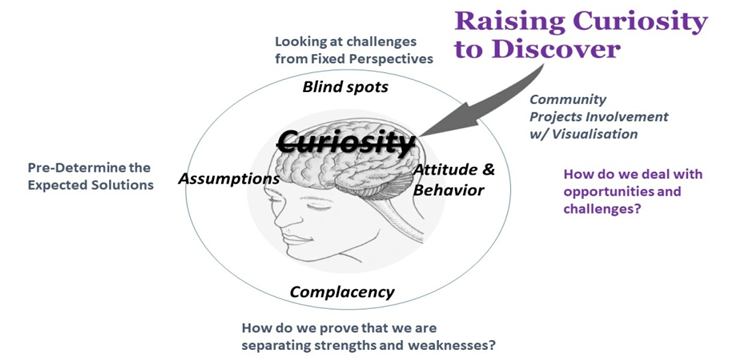 | Figure (1). Overcoming the Curiosity Economy Traps |
2.3. Main Sources of Curiosity and Future Foresight
- Curiosity can be designed based on the future foresighted developments. What triggers a curiosity in the past and today should not necessarily build your curiosity in the future. The more we want to have renewed insights, the more we should be engaged and curious in the future. Seeking to understand new, or coming experiences, future knowledge, with openness to change is part of future foresight. Miller (2018).The curiosity about future support by the extraordinary ability of our neurological connections helps us to use our imagination to develop our foresight and potential outcomes. Curiosity about the future triggers our imagination to reflect on some possible scenarios that come from novel approaches, data and a sense of imagination. Buheji (2019a).When we are curious, we could always generate and play with future ideas. Our foresight capability can help us to try new things and acquire new experiences constantly. Our future drive makes us always eager to know different people, and connected to patterns that other people cannot see. Future foresight makes us more persistent; because we want to get to achieve something unforeseen and with no evidence. This type of future foresight curiosity drives us to a higher sense of mission, purpose and meaning. UNDP (2014).In order to address the socio-economic status future foresight effectively, Buheji (2019a) mentioned about the importance of accepting ambiguity and exploring the different human capital or wealth. This would make us foresight the human, the natural, the social, the physical and finally the financial capital effectively. Figure (2) shows the different five main capitals of wealth that are used for future foresight.
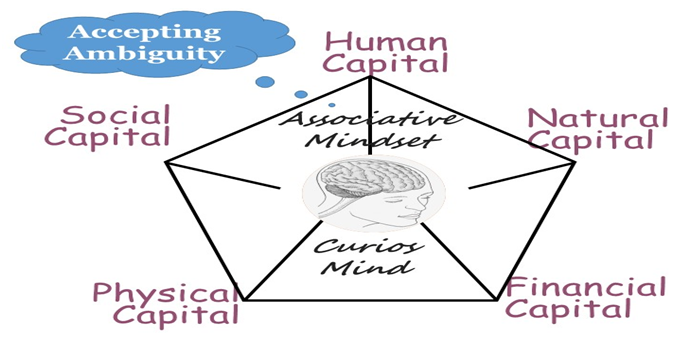 | Figure (2). The Five Capital of Wealth Used in Future Foresighting |
2.4. How Inspiration Economy is Using Curiosity?
- Inspiration Economy (IE) build projects through establishing a partnership between the university that has the curios force, that is students and the NGOs who are in the field. Then, IE tries to establish a collaborative socio-economic project that involves the whole community. IE target to establish models for the economy that use the intrinsic human powers to raise the capacity of the concerned to manage the socio-economic challenges. Issues as poverty, unemployment, families’ instabilities, migration, gender inequality, etc. need a curios driven mindset that explores ‘opportunities inside the problem’, Buheji (2019c), UNDP (2019).The curios mindset help to enhance the availability of the ‘non-financial wealth’ or assets of the socio-economic issues, thus establishing an outcome from both the ‘hidden wealth’ and the ‘unexploited opportunities’. Figure (3) shows the curiosity cycle that IE uses depends on ambiguity. The more IE expert lives with this ambiguity the more the exploration can lead to discovery, and the discovery can lead to a sustainable and breakthrough solution. Buheji (2018a), Eggers and Macmillan (2013).
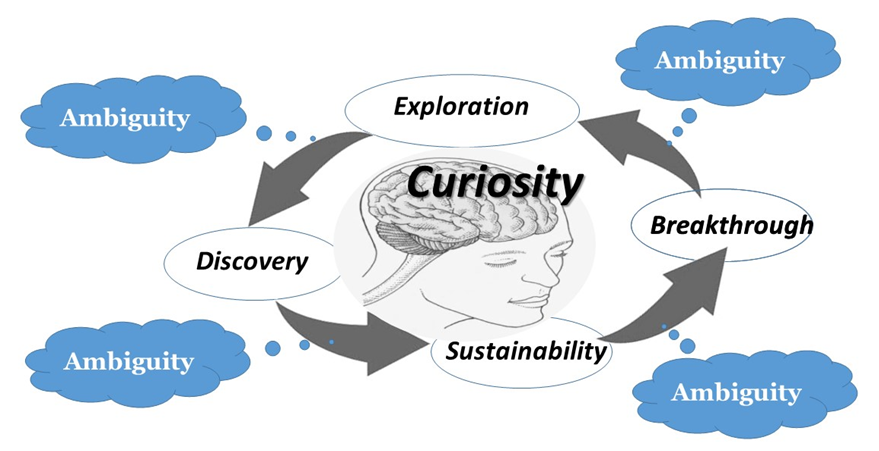 | Figure (3). Cycle of Curiosity in Inspiration Economy Projects |
2.5. Importance of Realising the Curiosity for Future Foresight
- Curiosity is a trait that can be seen in almost all people before the reach the age of seven years. However, this curiosity dissolves once most of us become moulded by the educational system, our parents, or the community surrounding us. Most of us by the time we finish 6th grade would have gone through a setup or a mindset and a surrounding that undermine what we used to believe in or imagine. Thus, over time we start to believe that what we dream in, or what we used to imagine not realistic. Our minds then become so trapped with many questions. We want to explore and learn about the world we are living in or the challenges of the future, but the fear of releasing these type of questions increases over time. In the meanwhile, today, we still live in a world mostly being more concerned about getting the right answer than asking disruptive questions. Therefore, in order to foresight the future, we need to have disruptive questions. The foresight of the future will not depend on categorising people based on standardised tests or classifying them based on grades or achievements, but rather on practices of explorations or attempts of differentiated contributions. UNDP (2014).The world started to appreciate not only our level of curiosity, but also what we are curious about. Specifying what fascinates us became a consistent question in any job interview. Following our passion is becoming highly appreciated by leading employers of today. We are actually expected to consistently nurture our curiosity with new discoveries and create new solutions for complex problems around us. Eggers and Macmillan (2013).The foresighted future carries with it people that do not like to be systematised, obeying orders without much questioning. What worked for a mass-production industry, does not work the fourth or fifth and future sixth industrial revolution, which depends on workers creativity and welling to be much more than being proactive. Curiosity is used more today in managing the dynamic changes, and this raises our imagination.The process of future foresight is similar to curiosity pathways. In both, curiosity and future foresight, we go through first observing “humbly” the possible interactions and then exploring and closely defining the scope. Then, learning from the interactions happens which improve the capacity to visualise again. Buheji (2019b).
2.6. Role of Multidisciplinary Perspectives in Triggering Curiosity
- Any socio-economic issue to be solved needs a multidisciplinary perspective, if it is to be solved effectively. Such issues bring together different background practitioners that would tackle the problem holistically. Buheji (2018a).Investing in multidisciplinary research and exploration would help to drive curiosity towards innovations and then commercialisation. Countries that invest in future foresight research usually have higher curiosity currency that influences the economy, due to their capacity for seeing the future from a holistic perspective. To enhance this curiosity, many governments are pushing towards much greater collaboration between universities, private sector and the community. Miller (2018).
2.7. Curiosity Raises the Capacity for Solution Differentiation
- Curiosity’ drives the problem solver to areas never thought of. Curiosity makes us dare to experiment in totally different communities and in different times, Buheji (2019a). Therefore, with curiosity queries, we can foresight about what makes the socio-economic problem different. For example, being curious about why do most the youth would continue to migrate in the future. Thus, foresight for the potential social change makes us more curios in finding the right problem, besides being curios of finding the right solution. UNDP (2019), Eggers and Macmillan (2013).Through this alternating finding the right problem or solution, we can build the excitement or the challenge towards the future foresight. At certain stages, we need to test the outcome in order to deliver a sustainable outcome, as shown in Figure (4).
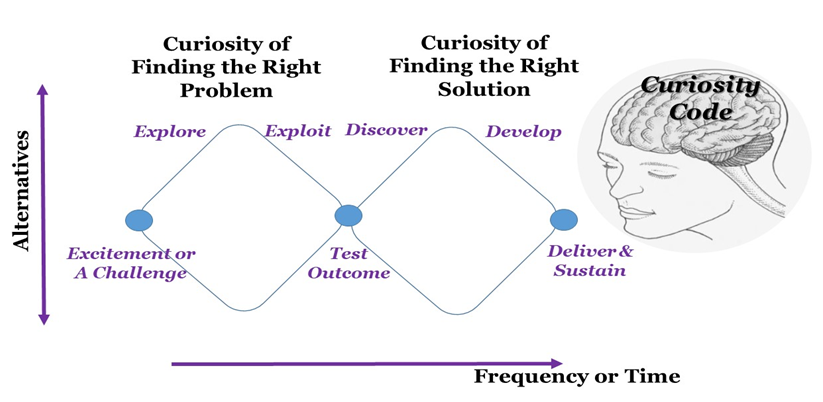 | Figure (4). Alternating between Curiosity for Right Problem and Right Solution |
2.8. Curiosity Economy of the Disruptive Inspiration Labs
- Curiosity increase with disruptive approaches. This is what inspiration labs are specifically unique about. Curiosity increases the purpose of tacking socio-economic problems in a totally disruptive way, where the opportunities inside the problem are exploited by investigating the ambiguity of economic and social complications. Chapman and Laoka (2018).The curiosity input accelerates the outcomes of socio-economic solution. This plays a very important for governments and NGO’s. Knowledge captured through curiosity during solving of problems differentiates the communities and its competitive productivity. This help to thrive the socio-economic development efforts of any community. For example, if governments understand the economic return of solving the socio-economic problem, as the problem of Waste Pickers NGO’s they could be part of the future transformation plans in the country’s waste management program. The curiosity economy of such problem ensures the development of innovative products and services that would guarantee the quality of life of all the beneficiaries.
2.9. Curiosity Economy Role in Solving Future Problems
- Eggers and Macmillan (2013) mentioned about the importance of curiosity economy in solving the challenging issue in today’s and future turbulent economy. Curiosity plays a pivot stone in the making any community face economic problems, which starts with facing how to make the best use of the limited, or scarce resources. The economics of curiosity tries to address the endless current and foresighted needs and wants with the limitation of the resources.Hence, in order to realise ways to nurture curiosity economy more focus now on making model cultures that encourage and appreciate associating things and questioning possibilities. The curiosity economy focuses on organisations that build their goals and targets a performance program around how to show genuine interest in people life development and values. Leading companies as Google are triggering the curiosity of its people towards the future through making their mindset to step back and ask themselves what are we missing. This is the essence of curiosity economy. It is an economy that help to build assumptions shack-up the mindsets. Thus, their economic value is much higher than the staff of any other company, as they are more excited to do a new adventure and expose themselves to more uncertainty. Chapman and Laoka (2018).
3. Methodology
3.1. Introduction to the References for the Methodology
- Based on the analysis and synthesis of the literature reviewed, the economics of curiosity and its influence on future foresight is investigated. Seven socio-economic issues tackled by the researcher through the Inspiration Economy Labs (IELs), published in Buheji (2018a), are deeply sampled again. These socio-economic issues would be evaluated in relevance to one or more of the types of curiosity, mentioned in Designing a Curios Life, Buheji (2019). Then the implications of each type of curiosity on the foresighted future of the socio-economic issue would be briefly synthesised.
3.2. Summary of Curiosity Types
- There are many different kinds and types of curiosity. This is due to curiosity can come in a whole variety of qualities and wavelengths, flavours and intensities. The different types of curiosity are the key to understanding people’s personalities and motivations. These different types of curiosity create the capacity of future foresight. Curiosity can trigger future foresight by different means. The different curiosity types would motivate different kinds of questions and this help to build a sense of purpose. The following curiosity types are selected based on a previous work of the researcher, Buheji (2019a). A framework for using curiosity and its economic constructs for more accurate future foresight is later proposed.
3.2.1. ‘Social’ Curiosity
- Social curiosity is about being involved with social issues and being able to connect effectively during a social gathering or events. Social curiosity helps to discover opportunities ingrained within the community. Many of the social curiosity was the cause of many changes in history. When we are inspired by a greater purpose in life, or new ideas, or projects that come as a result of this social curiosity, we actually help our thoughts and mind to transcend beyond limitations.
3.2.2. ‘Emotional’ Curiosity
- Curiosity can be described as positive emotions towards acquiring knowledge. Discovering new information may also be rewarding because it can help reduce undesirable states of uncertainty. Besides, curiosity is seen as a pleasurable experience that comes with exploratory emotional behaviours. Emotional curiosity can be seen with thinkers or leaders that become obsessed with creating a definitive change.
3.2.3. ‘Problem Ambiguity’ Curiosity
- Living with ambiguity means we will have an open mindset that manages the challenge of the new hypotheses while attempting to reduce the blind spots. Through ambiguity of any problem faced in life, we can build curiosity and thus avoid any negative thoughts. Neuroscience now shows that not knowing the answers actually inspires the human mindset as not knowing the clear path, or even the outcome of a socio-economic problem when we start, raises our curiosity for exploring and learning. This would help us to come up with creative solutions and pursue the outcome that we could not clearly visualise.
3.2.4. ‘Lifelong Learning’ Curiosity
- The advancement of neuroscience is making us appreciate the different constructs of curiosity. Now we know more than ever that curiosity can come from the state or the condition we are in, i.e. comes from extrinsic conditions, or due to our intrinsic traits, i.e. we can determine when curiosity occurs.
3.2.5. ‘Exploration then Exploitation’ Curiosity
- Exploration means searching for unknown or unfamiliar areas. You usually need a research technique or field study with a spirit of enquiry to achieve successful exploration. Exploitation, on the other hand, need intentional actions that target to benefit from resources around us. This probabilistic element causes them to occasionally explore other possibilities, leading them to better overall choices.
3.2.6. ‘Resilience’ Curiosity
- Resilience curiosity flourishes when we start the reasoning stage of what we experience. With active experimentation, or experiential learning, we start the curiosity journey of socio-economic problem solving and a positive mindset. Once inspired, people, organisations and societies become more resilient and tend to be more curious to explore the inner strengths and focus on outcomes while optimising resources. This applies again to organisations and societies even more individuals.
3.2.7. ‘Innovation’ Curiosity
- ‘Innovation’ driven curiosity can come from different dimensions. Excessive anxiety impedes human lust for new discovery. Curiosity brings in multidimensional creativity model that can be integrated into a single model. With ‘innovation’ curiosity, we recognise and seek-out new information and experiences. In creativity and innovation, the curiosity on the problem triggers the absorption dimension as a tendency to be fully engaged in activities.
3.2.8. ‘Productivity Focused’ Curiosity
- If we study the productivity of most organisations, it is usually linked to its capability to mobilise people and resources towards specific goals. Rarely we would see that the productivity of the organisation focused firstly and mostly on capacity. When organisations focus on developing its capacity, instead of making its goals, its capacity for discovering new opportunities will link curiosity with life-fulfilment goals and this would influence the organisation current and future performance.
3.2.9. ‘Intellectually Stimulated’ Curiosity
- Intellectually stimulated curiosity has been defined as instructors’ ability to challenge students and promote intellectual growth. Possible approaches through using an interactive teaching style which engages and challenge the students (e.g., making sure students know the material well and pushing students to do their best), or encouraging independent thoughts (e.g., helping students think critically and helping students come to their own conclusions about course material).
3.2.10. ‘Empathetic’ Curiosity
- Empathetic Curiosity can only be appreciated by experimenting and action, not by perception. When we actively experiment links of cognition within a specific environment, we enhance our perspectives of the problem investigated, and then our field contribution can be differentiated. In order to reach empathetic curiosity, we need to move our curiosity and exploration from focusing on money-making to meaning-making.
4. Case Study
4.1. Brief on the Inspiration Economy
- The inspiration economy focuses on tackling issues relevant to poverty, youth and women empowerment, unemployment, migration, community productivity, family stability, community diseases, inter-generation challenges, etc. Buheji (2018b).Since September 2015, the IIEP has tackled more than 300 types of projects in more than 13 countries. For the scope of this study, only seven different cases were selected to test the implication of the related curiosity type on the future foresight of the socio-economic. Buheji (2018a).
4.2. Defining the Future Foresight based on the Type of Curiosity
- Table (1) set up the relation between socio-economic issues, the type of curiosity and the implications of the foresighted future.
|
5. Discussion & Conclusions
- Being economically curios means we can build a mindset that has visualisation and future foresight thinking with the capacity to create realised developments in relevant to essential fields as tackling socio-economic challenges. Despite this study being testing with limited longitudinal study cases of different backgrounds, published by the research; all the socio-economic issues presented in Table (1) needs social, lifelong learning, resilient and empathetic curiosity in order to create a more specific and accurate future foresight action plan. Figure (5) represents the framework proposed for further studies. The framework comes as a result of the synthesis of the literature, and the case study presented. More test of the proposed framework in other fields than the socio-economic problem solving is highly recommended.
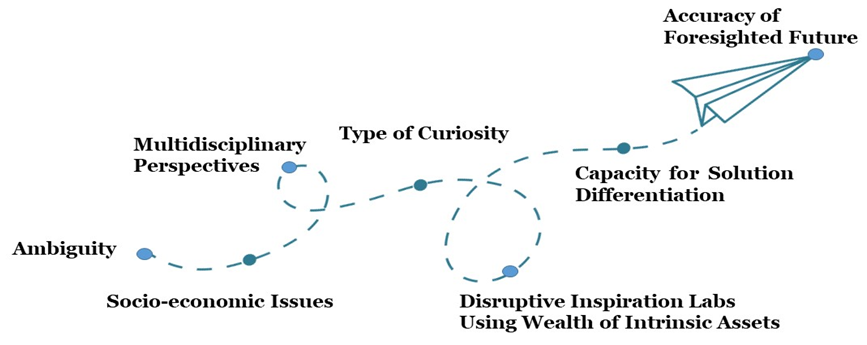 | Figure (5). Framework for Optimisation of Curiosity for More Accurate Future Foresight |
 Abstract
Abstract Reference
Reference Full-Text PDF
Full-Text PDF Full-text HTML
Full-text HTML